Arkle
b g 1957 (Archive - Bright Cherry, by Knight of
the Garter). Sire Line Phalaris.
Family 41.
To
regard Arkle's sire, the superbly bred wartime runner Archive,
as useless as a racehorse would not have been
entirely uncharitable. The pinnacle of his racing
achievements was second place in a division of a
one mile maiden race at the now defunct Stockton
racecourse. By Nearco, out of the St. Leger
winner
Book Law, it should not have been like that if one
followed the theory of breeding the best with the
best. His pedigree was classical to the core, and
laced with speed and stamina. But poor Archive
possessed neither of these qualities. When his
racing career ended it would have been no surprise
had he been dispatched to the glue factory, which
he certainly would have had he been from an
earlier age. Fortunately, fate intervened and he
lived to sire the greatest steeplechaser the world
had ever seen.
Arkle was bred by Mrs. Mary Baker, of
Malahow in County Meath. Her late husband had
often talked of sending Bright Cherry, herself an
excellent race mare, to Archive. Despite his lack
of class on the racecourse she liked his classic
breeding – and he was inexpensive. Had he been
the prolific winner his breeding might have
suggested, he would have commanded a considerable
fee at stud – and there would have been no
Arkle. As it was Archive was available for the
price of a gypsy’s pony.
And so
Bright Cherry made the visit to Archive at
Loughtown Stud, Co. Kildare, and about eleven
months later, on 19th April 1957, dropped
his foal at the Ballymacoll Stud just before the sun
rose over the Wicklow Mountains. Arkle, as yet
un-named, created no
great impression as a youngster other than being a
kind horse, very intelligent, and easy to get on
with. Had they known what they had on their hands,
the Bakers would no doubt have kept him. But he
had to go, and at Goff’s August 1960 sale he was
knocked down to the Duchess of Westminster for
1150 guineas, not a great price but over double
his reserve. The Bakers were happy.
Named
after a Scottish mountain that bordered the
Duchess of Westminster’s Sutherland estate, the
young Arkle, trained at Killsalaghan by Tom
Dreaper, prospered under his patient master.
Nothing electric: unplaced in a couple of bumpers;
some promising efforts over hurdles; a crashing
fall whilst schooling (the only time he ever fell)
and then came the Honeybourne Chase, a
two-and-a-half mile novices ’chase at
Cheltenham.
Like so
many good Irish horses, spectacular reports
preceded him. How they loved to frighten the
English. More often than not their claims were
discredited, but this did not deter the Irish from
backing him as if money was going out of style.
And Dreaper’s infant paid them back in
spectacular fashion, cruising to a twenty length
victory.
|
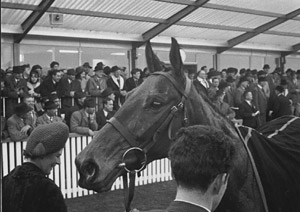
Arkle
at Cheltenham in 1965
© A. J. Byles |
Four
months later and rising six-years-old he was back
at Cheltenham for the National Hunt Festival and
the Broadway Novice’s Chase. It was another
annihilation. The Irish were already envisioning him
as the winner of the next year’s Gold Cup, and a
further opportunity to plunder the bookmakers'
satchels. But two days later their jaws must have
dropped in shocked disbelief when Arkle’s stable
companion, Fortria, was humbled by the English
giant, Mill House, in the Gold Cup. Although past his best
Fortria was top class, but Mill House had made him
look pretty ordinary. It was a
magnificent performance. The scribes were hailing
Mill House as the best since Golden Miller. He was, after
all, only a six-year-old, the same age as Arkle,
and could easily equal Golden Miller’s record of
five Gold Cups.
But
seasoned observers were not convinced; the issue
would not be settled until these two rising stars
had met. This was to be in the Hennessy Gold Cup
at Newbury. Such was
their reputation by then – Arkle had been unbeaten in
four races, including hacking up in a flat race,
since Cheltenham – that their rivalry had become
almost nationalistic.
One can imagine the
patronising tongues wagging around the Newbury
parade ring: “Yeah. Arkle’s a good horse,
alright. But look at Mill House – he could pick
Arkle up and carry him.” Mill House was indeed an
enormous beast, nearly seventeen hands, and
massively built. And sure enough, as the crowd
left Newbury on that cold November evening there
was no doubt that Mill House was the champion.
Arkle could only finish third – over eight
lengths behind.
The Irish were dumbfounded. They
knew how good Arkle was. Mill House must
be a wonder horse. But unnoticed through the mist
that hung over the racecourse, Arkle had slipped
on landing at the last open ditch, three fences
from home, almost sliding to a halt, and
blundering his way out of any chance he may have
had. This excuse when made known was greeted with the usual
expected scepticism. “Fences were there to be
jumped; unlucky as he may have been, Arkle had
failed to do so.” One sensed this may have been
a brave defence by those backers of Mill House who
knew what the outcome might have been had Arkle not
slipped.
Whatever the personal views, the outcome
had been inconclusive, setting up what was to be
an unforgettable epic in the annals of
steeplechasing when they met again in the
Cheltenham Gold Cup. There
were only two other runners: King’s Nephew and
Pas Seul, a previous Gold Cup winner now well past
his prime. Neither was considered a threat and
both took little part in the contest, which became a
match between the two favourites.
Mill House cut
out the early work. In the stands one could sense
the pounding hearts… and the silence, punctuated
with the gasps of oohs and aahs with each mighty
leap. Arkle matched him stride for stride, and
turning down the hill, with three fences to jump,
began to relentlessly cut down his lead. As they
turned for home Willie Robinson on Mill House went
for his whip; and Pat Taaffe began to shake up
Arkle. Robinson drove Mill House for all he was
worth, but he had given his all. Arkle took the
lead just before the last fence, and landing
safely, the stands exploded in a crescendo of
cheering, as Arkle raced home a five lengths winner.
Arkle’s
supremacy became overwhelming. No burden seemed
capable of stopping him. In their next meeting,
the following year’s Hennessy Gold Cup, Arkle
was set to concede three-pounds to Mill House.
Even this failed to bring them closer together;
poor Mill House being humbled by a twenty-eight
length defeat.
It is
probable that Arkle wasn’t fully fit for the
Hennessy, as he turned out a week later for
Cheltenham ’s Massey Ferguson Gold Cup, over a
distance short of his best and with a three-pound
penalty for his Hennessy win. With 12st. 10lb.
this was going to be no pushover. Buona Notte, a
super novice, and Flying Wild, a top class race
mare who looked more like an Oaks winner than a
’chaser, in receipt of twenty-six pounds and
thirty-two pounds respectively, would see to that.
But Arkle was no respecter of weight concessions.
Grabbing hold of his bit, and near pulling poor
Taaffe’s arms out, he confiscated the lead four
fences from home. Racing down the hill, as the
weight began to tell, the grey mare Flying Wild came at him;
then Buona Notte. Towards the last they both
headed him. Buona Notte crashed through the birch,
almost knocking the stuffing out of himself, but
recovered and closed on the mare. And Arkle,
having looked a beaten horse, also got going
again, grinding away at the strength-sapping hill
under his tremendous burden. It was the most
thrilling of finishes, Flying Wild holding on by a
short head from Buona Notte, with Arkle just a
length away.
Even in
defeat Arkle had been magnificent. Somehow it did
not seem to matter that he had been beaten. He had
conceded lumps of weight – not to two bottom of
the handicap plodders, but to two high class ’chasers,
both capable of winning top class races – and
yet he had suffered only a narrow defeat. To many
he was the moral
victor.
|
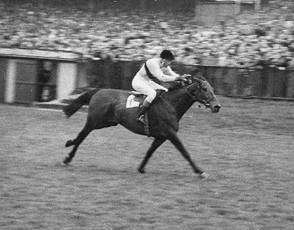
Winning the Whitbread Gold Cup at
Sandown Park in April, 1965
© A. J. Byles
|
Over the next two years Arkle was unbeaten,
winning two more Cheltenham Gold Cups, a second
Hennessy Gold Cup, Kempton Park’s King George VI
’Chase, Sandown Park’s Whitbread Gold Cup, and a
newly framed race: the Gallaher Gold Cup, in which
he gave Mill House sixteen pounds and a
twenty-four length beating – and broke the course
record by seventeen seconds. In handicapping terms
this put him nearly three stone (42 lb.) superior
to Mill House. Was it possible that one Gold Cup
winner was almost three stone superior to another?
|
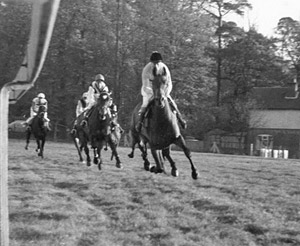
© A. J. Byles |
|
Arkle
leading Mill House past the members' car park
on his way to winning the Gallaher Gold Cup at
Sandown Park in November, 1965 |
Defeat finally came trying to win his third Hennessy
Gold Cup. It was the Handicapper that beat him;
though even he couldn’t have foreseen his
misdemeanour. The lightly weighted grey, Stalbridge
Colonist, was in with only 10 st. Although a winner
of almost a dozen races the previous season, he had
never won a race beyond two-and-a-half miles, and
the previous weekend had finished forty lengths
behind Arkle’s stable mate, Dicky May, in a race at
Ascot. And there was Arkle, with his usual 12 st.
7lb. It had hardly troubled him before – why now?
But Stalbridge Colonist, with the benefit of the
super lightweight jockey Stan Mellor on his back,
launched himself at the last fence - and had the temerity to outjump Arkle half
a length and, more importantly, the impetus to take
him clear. For a moment it appeared that Stalbridge
Colonist would win easily but, battling on gamely
(one could never accuse Arkle of giving in without a
fight), Arkle began to close. His prodigious burden,
however, proved just too much - yet he went down by
only half a length.
Did
this mean that Arkle, in his first race of the
season and possibly a shade unfit, was on the wane?
Not in the slightest. Within a few weeks he was back
in England (Arkle trained in Ireland) this time for
the S.G.B. Handicap ’chase at Royal Ascot. Such was
his popularity that the attendance was over a third
up on the previous year’s meeting. Arkle did not
disappoint them. He took the lead at the first fence
and was never headed, winning by fifteen lengths and
conceding 35 lb. to the runner-up. Another
magnificent weight-carrying performance made it
fitting that his name could now be added alongside
the great champions that had won on the Royal Heath.
|
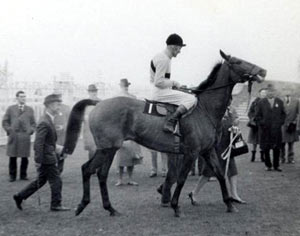
Arkle
following his win in the S. G. B.
Handicap 'chase
at Royal Ascot in 1966
© A. J. Byles |
It
now seemed a mere formality that Arkle would win a
fourth Cheltenham Gold Cup. There was just Kempton
Park’s King George VI Chase to overcome – a
conditions race he had won the year before – in
which he only had to concede 21 lb. to his six
opponents. But almost from the start Pat Taaffe
sensed something was wrong. Arkle was jumping to the
left on a right handed track (in hindsight he had
done the same over the last few fences at Ascot ).
It was clear that Arkle, if not struggling, was not
the Arkle we knew. Invisible from the stands, Arkle
had clipped the guard rail at the second fence with
his off-fore, splitting the pedal bone. But a
cracked pedal bone was certainly not going to stop
him now.
Woodland Venture, the most likely danger, and an old
adversary, Dormant, whom Arkle had distanced in the
same race the previous year, both had a go at him.
But Arkle never surrendered his lead easily, and he
still led at the end of the first circuit. At the
first fence in the back straight – and Kempton’s
fences were not to be trifled with – Arkle went
straight through it; in much the same way he had
done at Cheltenham when winning his third Gold Cup.
A gasp from the crowd; followed by a sigh as his
remarkable balance rescued him. Biddlecombe drove
Woodland Venture into the lead, but Arkle was having
none of it, and by the next fence he was back in
front.
By
the second last, when Arkle would have normally
taken leave of his field, Woodland Venture was still
hanging on, and he challenged for the lead again.
Almost upsides of Arkle as they took off, Woodland
Venture crashed to the ground, leaving Arkle alone.
Only one fence left and he would be home.
But
creeping out of the depth of winter mist was
Dormant, who under normal circumstances would not
have caught Arkle if he had run to the end of the
world. Dormant now appeared to be closing on Arkle
at a phenomenal rate. The crowd was willing Arkle on
– completely unaware of the excruciating pain that
was stabbing into his off fore every time it touched
the ground.
At
the last fence Dormant was six lengths in arrears
and even in receipt of 21 lb. his task looked
formidable. But on the run-in the race took a
dramatic change. Arkle’s stride faltered and
shortened as Dormant relentlessly cut down his lead.
It was only twenty yards from the winning post that
Dormant finally caught him, but so slow was Arkle
going now (he had almost slowed to a trot as he
passed the winning post) that Dormant had a length
to spare.
As
Pat Taaffe – who worshipped the only perfect horse
he had ever sat on – was led in, the anguished
expression on his face told the whole story: Arkle
had broken down. It was an anguish shared by all who
had followed this great horse.
His
injury was serious enough: the pedal bone was split
over two inches. One must wonder at the pain he must
have experienced racing over three miles – never
attempting to pull-up, but fighting to the bitter
end. Little wonder the public took him to their
hearts.
A
fourth consecutive Gold Cup was now out of the
question; in fact the possibility of never seeing
him on a racecourse again - and thus the end of an
era - dawned on us.
|
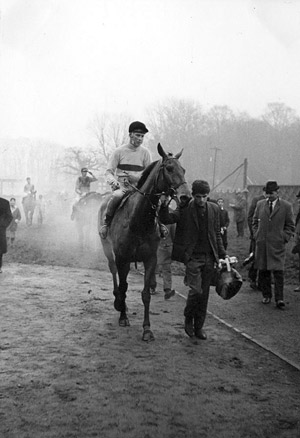
|
Arkle coming in lame after his last race, the King George VI
'chase at Kempton
Park, in December, 1966
© A. J. Byles |
|
As
famous as Arkle had been on the racecourse, it was
excelled by his fame as a patient. Regular bulletins
appeared in the press and on television and radio.
Get-well cards and letters adorned his box. Such was
his celebrity that an address was unnecessary; cards
and letters simply addressed "Arkle, Ireland" found
their way to his box.
Arkle
made good progress. The bone healed; special races
were framed for him to assist his preparation for
a fourth Gold Cup; not a stone was left
unturned to get him back on the racecourse. But
the Gold Cup came and went – won by Arkle’s
stable companion Fort Leney, and the next one, won by the twelve-year-old What a Myth - both
rated at least three-stone (42 lb) inferior to
Arkle.
Just a
few months short of two years since that sombre
day at Kempton, when Arkle passed a winning post
for the last time, the Duchess of Westminster
announced his retirement. In some way our
disappointment was tempered by the relief that
this equine masterpiece would never again be risked to
reproduce the brilliance he had shown over almost
four spectacular seasons. He was nearly twelve
years old and the possibility of him having to
struggle against nonentities, who in his prime
would have been dispatched with ease, would have
been too much to bear.
And that
was very nearly the end of Arkle. He made a few
more public appearances at the Horse of the Year
Show where he delighted his public. Ears pricked,
listening to the applause of the crowd, perhaps he
may have thought he was going racing again.
On one evening he fed on apples and pears from a
fruiterer’s cart, and on another, the show’s
hydrangeas, in much the same way as the Duke of
Westminster’s Ormonde had fed on geraniums and
orchids at a Grosvenor House Party nearly a
century before.
Spring came, and with it an increasing
stiffness in his hindquarters. It became
so bad that he was having trouble
moving, and there was the possibility of
him lying down and being unable to get
up. One can imagine the thoughts of the
Duchess of Westminster as she saw him
for the last time – lying down, those
powerful memories flashing before her.
Perhaps she would have remembered the
afternoon of March 7th 1964 – Gold Cup
Day. It was the day she saw the greatest
steeplechaser she had seen in a lifetime
win the race of the year: Mill House and
Arkle, stride for stride, racing for the
final turn to face the famous Cheltenham
hill; Robinson on Mill House going for
his whip, and Taaffe shaking up Arkle.
She would remember the relief as Arkle
took the lead at the last fence and
raced away as if the whole of Ireland
was shouting him home.
It was a Sunday afternoon, around
teatime. Just six years had passed by to
that fateful day: 31st May
1970; Arkle took his final injection and
passed into the hand of legend.
|
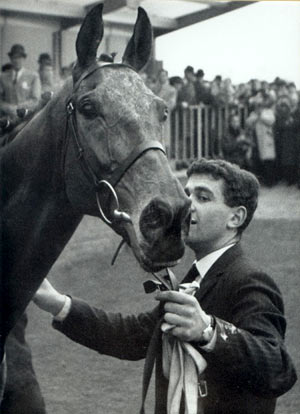
Arkle was buried at the
Duchess of Westminster's
farm at Bryanstown, near
Maynooth,
County Kildare, Ireland.
© A. J. Byles |
|
|
Arkle is pictured above with
his lad Johnny Lumley. He
did not ride and was given
both Arkle and Flyingbolt
when he went to work for Tom
Dreaper. Flyingbolt
(Airborne), a flashy chesnut
with a vile temper, was also
one of the best. In 1966 at
Cheltenham he won the
Champion Chase and the next
day finished third in the
Champion Hurdle. |
|
There
were great steeplechasers before Arkle: The Lamb
and Manifesto; and of the latter day marvels, Easter Hero, Cottage Rake, and of course Golden
Miller, among many others. There have been great
runners since; but Arkle’s performances on the
racecourse have left his name, after nearly half a
century, one to conjure with. A measure of his
greatness rests with his course record carrying 12
st. 7lb. over three miles at Sandown Park, set in
1965, which still stands to this day, and what
other equine masterpiece has forced such a change
in the rules of racing? Handicaps were framed with
two sets of weights: one if he ran and one if he
did not, to prevent all the runners from being
lumped together on the lowest weight.
Arkle
was incomparable. Not only was he a great athlete,
but he had an inexplicable presence that captivated
all who were touched by him. The adulation with
which he was regarded extended beyond the racing
public. There was no doubt he was arrogant, as
could be testified by the way he would appear to
swagger round the parade ring or savour the
applause after one of his victories. And the
heights he would sometimes clear his fences
- was
he not just taking the rise out of the opposition?
Yes, arrogant he may have been. But he had plenty
to be arrogant about.
It is no
hyperbole that Arkle – a freak of nature – was
the greatest steeplechaser since Messrs O’Callaghan
and Blake raced their horses from St. John's
Church, Buttevant to St. Mary's Church, across
from Doneraile Park, St. Leger over two centuries ago, and so
set the sport of steeplechasing a-galloping.
There may have been others fit to name in the same
breath but none has left us with a legacy of such
supremacy.
Maybe,
in some distant time, there will be an equal, but
certainly in the lifetime of the writer of these
lines, it seems doubtful that we shall ever see
his like again.
Anthony Byles
Thanks to Sandra Snider, editor
extraordinaire, for all her help